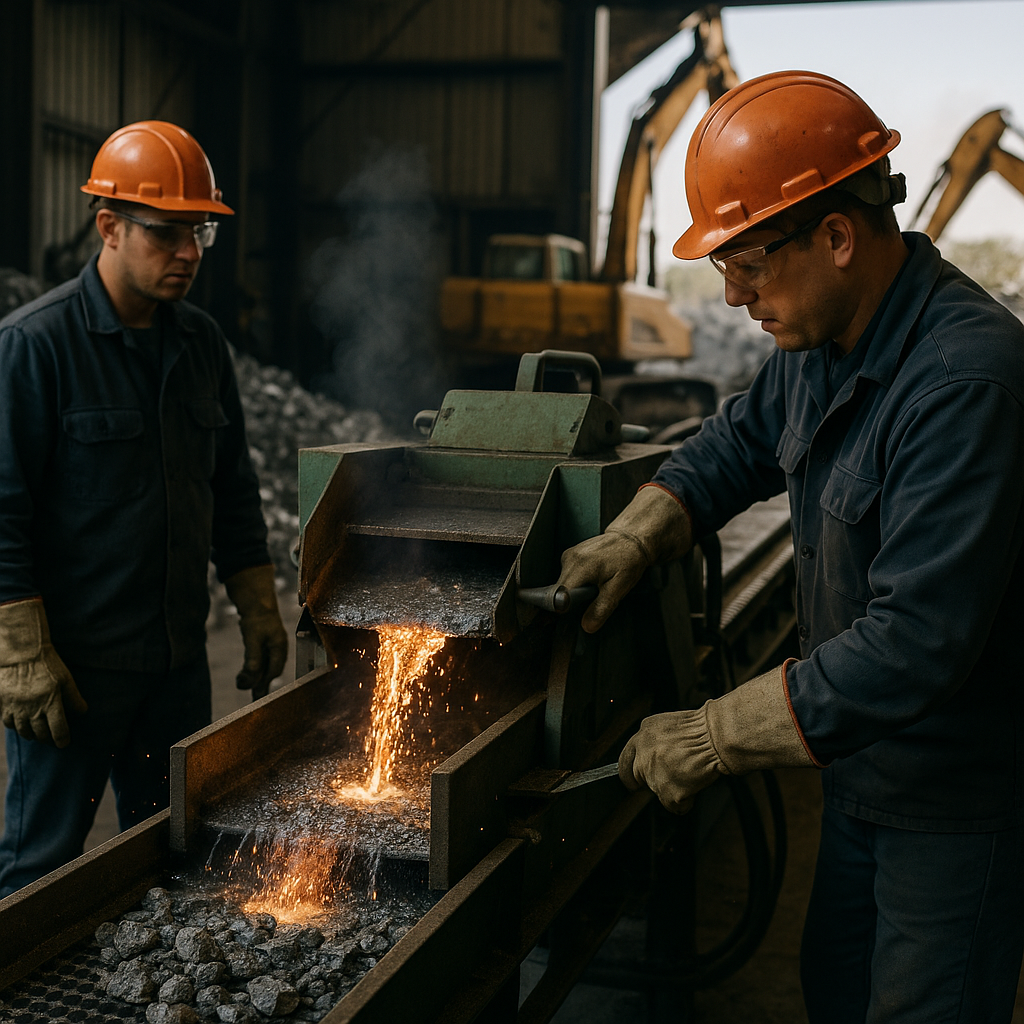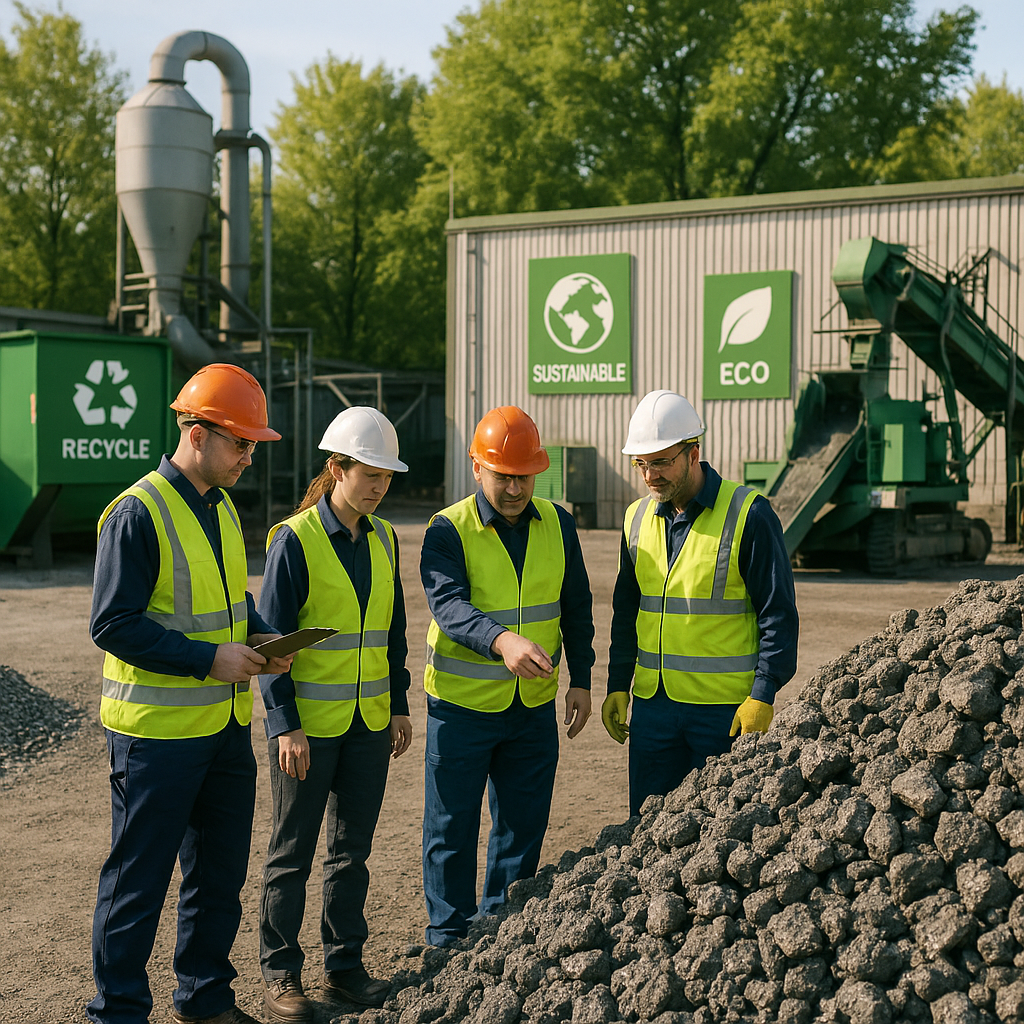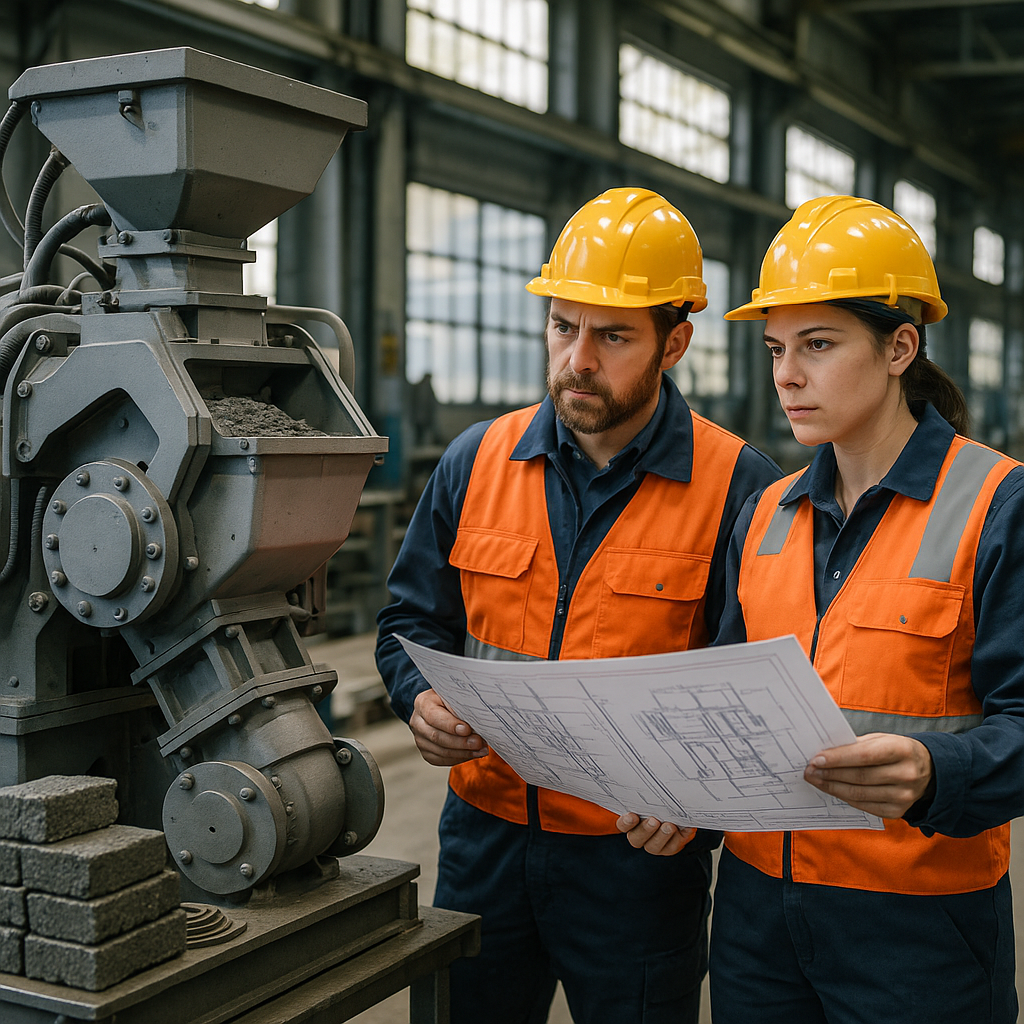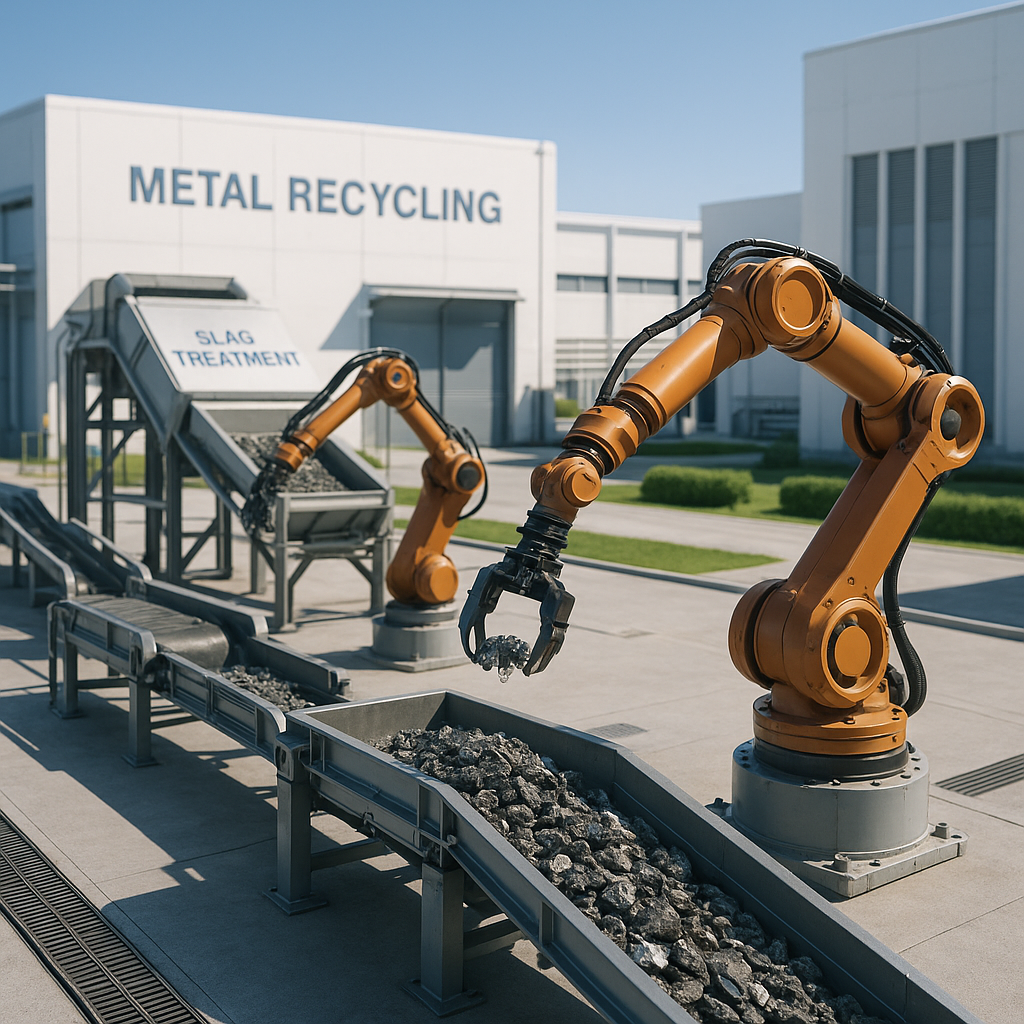5901 Botham Jean Blvd, Dallas, TX 75215
Slag Importance in Metal Recycling: Treatment Processes, Sustainability, and Innovations
October 4, 2025In metal recycling, one material often goes unnoticed despite its critical role: slag. Formed during smelting and refining, slag is the rocky, sometimes glass-like byproduct that separates from molten metal. Though it may not have the shine of refined metals, it plays a crucial part in recycling processes.
Slag isn’t just waste—it’s a functional material made up of metal oxides and silicon dioxide, with its composition varying by metal type. In steelmaking, slag often contains calcium, silicon, magnesium, and aluminum oxides, while copper slag features iron and silicon oxides. These differences give each type of slag unique properties and recovery potential.
Far from being discarded, slag serves three essential functions: it captures impurities from molten metal, forms a protective layer that prevents oxidation and heat loss, and acts as a valuable secondary resource for extracting recoverable metals. By treating slag not as waste but as an opportunity for resource recovery, the recycling industry boosts both efficiency and sustainability.
What are the Main Processes for Treating Slag in Metal Recycling?

Slag treatment in metal recycling employs several specialized processes to recover valuable metals and prepare the material for beneficial reuse. Each method targets specific properties of slag to maximize resource recovery while minimizing environmental impact.
Magnetic Separation
Magnetic separation is among the most efficient methods for recovering ferrous materials from slag. This process uses low-intensity drum separators to attract and separate magnetic metals from non-magnetic components. It is most effective when employed on uncrushed slag before additional processing.
The efficiency of magnetic separation depends on the iron content in the slag. In steel mill operations, this method can recover significant quantities of metallic iron that might otherwise be lost. Modern magnetic separation systems can process large volumes continuously, making it essential in industrial slag recycling operations.
Flotation Techniques
Flotation separates valuable minerals based on differences in surface properties. Reagents are added to a water-slag mixture to make certain minerals water-repellent. When air bubbles through the mixture, these hydrophobic minerals attach to the bubbles and rise to the surface for collection.
This technique is particularly effective for separating non-ferrous metals and sulfides from slag. Flotation success depends on factors including particle size, reagent selection, and pulp density. Flotation cells are often arranged in series to improve separation efficiency and maximize metal recovery rates.
Pyrometallurgical Processes
Pyrometallurgical treatments use high temperatures to extract and separate metals from slag. Key processes include:
Reduction roasting converts metal oxides in slag to their metallic forms using reducing agents like carbon or hydrogen. This usually occurs at 500-1200°C, depending on the target metals.
Smelting reduction uses even higher temperatures to melt slag, allowing metals to separate by density. This method can recover copper, nickel, and other valuable metals from complex slag compositions. Advanced systems include dust containment and off-gas treatment to minimize environmental impacts.
Hydrometallurgical Methods
Hydrometallurgical approaches dissolve target metals from slag using aqueous solutions. Acid leaching, using reagents like sulfuric, hydrochloric, or nitric acid, is the most common technique for extracting metals from the slag matrix. It is particularly effective for recovering copper and precious metals.
The benefits of hydrometallurgy include lower energy requirements than pyrometallurgical methods and better control over the process. However, these techniques generate wastewater requiring treatment. Innovations such as bioleaching, where microorganisms assist in metal extraction through natural metabolic processes, are emerging.
After leaching, metals can be recovered from the solution through precipitation, solvent extraction, or electrowinning, depending on the specific metals and their concentrations.
Mechanical Processing
Mechanical processing prepares slag for both metal recovery and beneficial reuse. It includes crushing to reduce particle size, screening to separate different size fractions, and grinding to produce fine powders.
These processes serve dual purposes: they liberate metals trapped in the slag matrix, making them accessible for recovery by other methods, and create material with specific size characteristics suitable for construction aggregates, cement production, or soil amendments.
The effectiveness of mechanical processing depends on equipment selection and operating parameters. Modern facilities often incorporate automated systems that adjust processing based on slag composition and desired output specifications.
Emerging Technologies
Innovative approaches to slag treatment are continually emerging as researchers seek more efficient and environmentally friendly methods. Supercritical CO2 extraction shows promise as a green alternative to traditional processes, operating at lower temperatures (35-70°C) and pressures (75-100 bar) to extract metals while minimizing chemical waste.
Other innovations include advanced sensor-based sorting technologies that can identify and separate slag components based on optical, x-ray, or electromagnetic properties. These systems enhance sorting accuracy while reducing energy consumption compared to traditional methods.
By combining multiple treatment processes, recycling facilities can maximize metal recovery rates and transform what was once considered waste into valuable resources, contributing to a more sustainable circular economy.
How Does Slag Recycling Contribute to Sustainability in the Metal Industry?

Slag recycling transforms a once-discarded byproduct into a valuable resource. This process significantly reduces waste volume in the metal industry, where steel production alone generates over 250 million tons of slag annually. By recycling slag instead of landfilling it, metal producers prevent contaminants from leaching into soil and water while conserving valuable disposal space.
Reusing slag directly conserves natural resources through multiple pathways. When slag is processed into construction aggregates, it reduces the need to quarry stone. Ground granulated blast furnace slag can replace up to 70% of Portland cement in concrete mixes, preserving limestone and other raw materials used in cement production. This substitution creates a double benefit: conserving resources while reducing the energy-intensive cement manufacturing process.
Energy savings are another crucial sustainability advantage of slag recycling. Traditional cement production requires substantial energy for heating and processing raw materials. Using slag as a cement replacement bypasses much of this energy consumption. Additionally, when metals are recovered from slag through processes like magnetic separation, they can be returned to production without the energy-intensive mining and refining required for virgin materials.
The construction industry benefits tremendously from recycled slag products. Air-cooled slag provides excellent base material for highways and railway ballast due to its rough, angular texture that creates stable foundations. Slag aggregates in asphalt enhance road durability and skid resistance, extending the lifespan of infrastructure projects while reducing maintenance needs and resource consumption.
From a circular economy perspective, slag recycling creates multiple value streams from what was once considered waste. Steel companies can offset production costs by selling processed slag rather than paying for disposal. Meanwhile, builders gain access to more affordable and often more durable materials than traditional options. This economic benefit reinforces sustainable practices throughout the supply chain.
The carbon footprint reduction achieved through slag recycling is substantial. Each ton of slag cement used in place of traditional Portland cement can reduce CO₂ emissions by up to 50%. The steel industry’s carbon-intensive processes become more sustainable when their byproducts reenter the economy as valuable materials rather than waste. This approach aligns with global efforts to decarbonize heavy industry and construction sectors.
Agricultural applications represent another sustainable use for slag. Lime-rich slags can be applied to acidic soils to improve fertility, reducing the need for manufactured soil amendments while putting otherwise wasted materials to productive use. This demonstrates how slag recycling extends sustainability benefits beyond industrial applications into food production systems.
What Challenges and Innovations Exist in Slag Treatment Technologies?

The slag treatment industry faces several technical hurdles that impact efficiency and environmental compliance. Metal recovery rates remain a primary challenge, with current processes often unable to extract all valuable elements economically. The heterogeneous chemical composition of steel slags complicates accurate modeling of dissolution kinetics, making standardized treatment protocols difficult to establish.
Hazardous element management presents another significant challenge. Steel slags, particularly from electric arc furnaces, can contain elevated chromium levels that pose environmental risks. Conventional leaching methods may fail to properly immobilize these contaminants, creating potential barriers for beneficial reuse. The energy-intensive nature of many slag processing technologies also conflicts with sustainability goals, as carbonation of natural minerals requires additional processes like mining, transportation, and grinding.
Slow reaction kinetics further hinders progress in slag valorization. Under atmospheric conditions, carbonation processes proceed at rates too slow for industrial viability. Current research aims to overcome these rate-limiting steps through innovative approaches while maintaining economic feasibility.
Innovative Approaches to Slag Treatment
Recent technological breakthroughs are transforming slag management practices. Enhanced flotation techniques using specialized reagents show promise for improving separation efficiency. These innovations allow for more selective metal recovery from complex slag matrices, with research indicating potential increases in extraction yields of calcium and magnesium ions.
More efficient leaching methods represent another advancement in the field. Indirect carbonation offers benefits through superior purity of end products but requires effective extractants. Studies show that acetic acid, with its limited corrosive properties, provides a viable alternative to strong acids while enabling recovery after the extraction process.
Process optimization through parameter control is gaining traction. Researchers have identified optimal conditions for slag carbonation, including particle sizes between 20-200 μm and reaction durations around one hour. Temperature control around 100°C generally supports carbonation while aligning with industrial waste heat ranges. These refinements make implementation more practical at commercial scales.
Novel Applications for Treated Slag
CO2 sequestration represents a promising frontier for slag utilization. The carbonation process mimics and accelerates natural weathering, with steel slags proving suitable due to their high calcium and magnesium oxide content. Studies indicate that using 4.7 tons of steel slag could result in the absorption of one ton of CO2, producing 2.3 tons of calcium carbonate.
Value-added materials production offers economic incentives for slag treatment. Precipitated calcium carbonates derived from carbonation processes find applications in construction materials, paper, and paint filler. This approach transforms waste management costs into potential revenue streams.
Construction applications for carbonated slag are expanding. Research shows that the carbonation process improves the hydraulic properties of steel slag, making it suitable for use as supplementary cementitious material. Carbonated slag concrete exhibits promising compressive strengths in the range of 36.2–45.5 MPa at 28 days, comparable to conventional materials.
Soil stabilization represents another innovative use case. Carbonated steel slag helps neutralize acidic soils and immobilizes heavy metals by forming stable complexes within the soil matrix. The binding action of calcium carbonate also enhances soil aggregate stability, improving resistance to erosion.
Conclusion: The Future of Slag Treatment in Metal Recycling

Slag treatment is rapidly evolving as a crucial aspect of sustainable metal recycling. The industry is shifting from viewing slag as waste to recognizing it as a valuable resource with significant potential. Technologies like electric field strengthening treatment represent the forefront of innovation, offering efficient recovery of valuable elements while significantly reducing environmental impact. These methods achieve impressive recovery rates—over 80% for phosphorus from steel slag and 85% for sulfur from ladle furnace slag—without the drawbacks of traditional processes.
As global environmental regulations strengthen and circular economy principles become industry standards, we can expect accelerated adoption of zero-waste approaches across the metal recycling sector. The future will likely bring further refinements to direct recycling methods, advanced sorting technologies using artificial intelligence, and increased collaboration within the industry to create closed-loop systems that maximize resource efficiency. For companies looking to improve sustainability while enhancing operational efficiency, now is the time to explore these innovative slag treatment options. Contact Okon Recycling at 214-717-4083 for your recycling needs.
